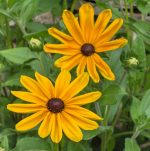 Also known by many other names including gloriosa daisy, this native of eastern and central North America is a member of the aster family, Asteraceae, that also includes daisy, yarrow, and lettuce. It grows 2-3′ tall and has bristly hairs covering the stout branching stems, the undersides of leaves, and the flowerheads. The lanceolate leaves are entire, 2-4″ long and usually three-ribbed. From mid summer to early fall solitary daisy-like flowerheads 2-4″ across appear that have a domed center of brown to black disc flowers surrounded by yellow ray flowers. Cultivars are available that are single or double, vary in height, and have various shades of yellow, orange, gold, and mahogany red ray flowers. The plants may decline in rainy or humid weather due to foliar diseases. Black-eyed Susans are good cut flowers and the plants are a good choice for wildflower, native plant, cottage, and cutting gardens. The genus name, Rudbeckia, honors Olof Rudbeck (1630-1702) a Swedish botanist and founder of the Uppsala Botanic Garden, and his son Olof Rudbeck the Younger a friend of Linnaeus. The specific epithet, hirta, is the Latin word meaning hairy and refers to the hairs on the stems and leaves that distinguish this species from other members of the genus.
Also known by many other names including gloriosa daisy, this native of eastern and central North America is a member of the aster family, Asteraceae, that also includes daisy, yarrow, and lettuce. It grows 2-3′ tall and has bristly hairs covering the stout branching stems, the undersides of leaves, and the flowerheads. The lanceolate leaves are entire, 2-4″ long and usually three-ribbed. From mid summer to early fall solitary daisy-like flowerheads 2-4″ across appear that have a domed center of brown to black disc flowers surrounded by yellow ray flowers. Cultivars are available that are single or double, vary in height, and have various shades of yellow, orange, gold, and mahogany red ray flowers. The plants may decline in rainy or humid weather due to foliar diseases. Black-eyed Susans are good cut flowers and the plants are a good choice for wildflower, native plant, cottage, and cutting gardens. The genus name, Rudbeckia, honors Olof Rudbeck (1630-1702) a Swedish botanist and founder of the Uppsala Botanic Garden, and his son Olof Rudbeck the Younger a friend of Linnaeus. The specific epithet, hirta, is the Latin word meaning hairy and refers to the hairs on the stems and leaves that distinguish this species from other members of the genus.
Type: Annual or short-lived perennial
Bloom: Solitary flowerheads consisting of brown or black disc flowers surrounded by yellow ray flowers
Size: 2-3′ H x 2′ W
Light: Full sun
Soil: Average, moist to dry, well-drained; water as little as possible and in the morning to discourage foliar rot
Hardiness: Not hardy
Care: Deadhead to prolong bloom and discourage foliar disease
Pests and Diseases: Foliar diseases in wet/humid climates,
Propagation: Seed (self-seeds)
Companion Plants: Butterfly weed, purple coneflower, tall tickseed
Outstanding Selections:
‘Becky’ (mixed colors, 1′ tall)
‘Gloriosa’ (semi-double to double, up to 6″ wide flowers, 3-5′ tall)
‘Green Eyes’ (greenish center)
”Indian Summer (very floriferous, 6″ side flowers, 30″ tall)
‘Sonora’ (mahogany-red center area on yellow ray flowers, 15-20″ tall)
Photo Credit: Wikipedia